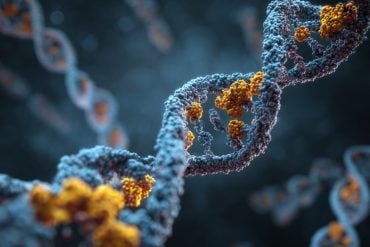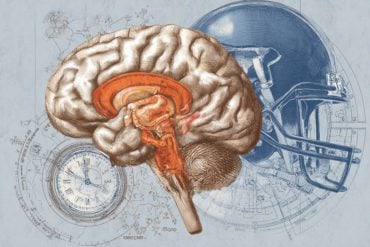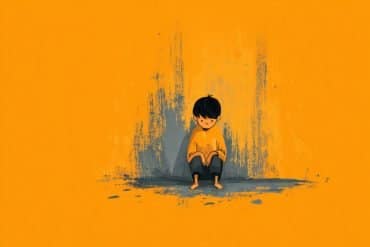Summary: Why do we seem to enjoy movies and art that are emotionally negative or designed to make us feel sad? Researchers from Max Planck Institute have developed a new model that may help explain this paradox.
Source: Max Planck Institute.
Why do we enjoy music, poems, novels and films that make us feel sad or even horrified? Researchers at the Max Planck Institute for Empirical Aesthetics have developed a new psychological model that explains this seemingly paradoxical phenomenon.
Recent research in the psychology of emotion has shown that negative feelings are particularly effective in capturing our attention, are experienced especially intensely, and enjoy privileged access to memory. Max Planck researchers working with Winfried Menninghaus, Director of the Department of Language and Literature at the Max Planck Institute for Empirical Aesthetics, were intrigued by these findings. After all, the arts precisely strive for what negative emotions are particularly good at: to secure attention, elicit intense subjective responses and to be memorable. Hence the researchers asked: Could it be that negative feelings are actually predestined resources for the arts rather than only paradoxical licenses in exceptional cases?
Based on their psychological model published in the renowned journal Behavioral & Brain Sciences, the researchers have answered this question affirmatively. Their Distancing-Embracing model explains why we often experience artworks involving us in negative emotions as more intense, interesting, emotionally moving and less boring, and, indeed, often even as more beautiful than artworks lacking the spices of negative emotions.
The model is based on two factors. The first has already been well studied: we cognitively subsume our exposure to works of art under a different category than our responses of day-to-day reality. This cognitive distancing creates a kind of protective space in which we can experience negative emotions.
No tension without anxiety
The second factor, the real heart of the new model, includes several mechanisms that allow us to embrace negative emotions in a thoroughly positive way. The first is based on the great importance of variation and dynamics in aesthetic experience: artistic compositions that involve us in interplays of positive and negative feelings are experienced as more varied, exciting and interesting. In addition, mixed feelings, in which positive and negative feeling intermingle, are of great importance for integrating negative emotions into an overall positive experiential pleasure. This explains why our experience of being deeply emotionally moved is positive and pleasurable, even if it also comprises sad feelings. Similarly, we cannot undergo positive, exciting feelings of narrative tension in the absence of feelings of “uncertainty”, worry and fear for protagonists.

The aesthetic power of the representation itself (for example, the beauty of the music, the words, the language and colours) is also shown to render the experience of negative emotions both more intense and more positive. Finally, the search for meaning can result in discovering something positive in negative emotions.
Thus, the Distancing-Embracing model explains the old “paradox of tragedy” of the enjoyment of negative emotions by combining recent discoveries in the psychology of emotion with basic principles of aesthetic perception. The model explains not only why we enjoy certain genres such as tragedies, horror films or melodramas. Rather, it proposes fundamental psychological mechanisms, which are responsible for the perception of works of art or media products altogether.
Source: Winfried Menninghaus – Max Planck Institute
Publisher: Organized by NeuroscienceNews.com.
Image Source: NeuroscienceNews.com image is adapted from the MPG news release.
Original Research: Abstract for “Negative emotions in art reception: Refining theoretical assumptions and adding variables to the Distancing-Embracing model” by Winfried Menninghaus, Valentin Wagner, Julian Hanich, Eugen Wassiliwizky, Thomas Jacobsen, and Stefan Koelsch in Behavioral & Brain Sciences. Published online November 29 2017 doi:10.1017/S0140525X17001947
[cbtabs][cbtab title=”MLA”]Max Planck Institute “Beautifully Sad: Why We Enjoy Negative Emotions in Movies and Art.” NeuroscienceNews. NeuroscienceNews, 4 December 2017.
<https://neurosciencenews.com/movies-negative-emotions-8104/>.[/cbtab][cbtab title=”APA”]Max Planck Institute (2017, December 4). Beautifully Sad: Why We Enjoy Negative Emotions in Movies and Art. NeuroscienceNews. Retrieved December 4, 2017 from https://neurosciencenews.com/movies-negative-emotions-8104/[/cbtab][cbtab title=”Chicago”]Max Planck Institute “Beautifully Sad: Why We Enjoy Negative Emotions in Movies and Art.” https://neurosciencenews.com/movies-negative-emotions-8104/ (accessed December 4, 2017).[/cbtab][/cbtabs]
Abstract
Negative emotions in art reception: Refining theoretical assumptions and adding variables to the Distancing-Embracing model
While covering all commentaries, our response specifically focuses on the following issues: How can the hypothesis of emotional distancing (qua art framing) be compatible with stipulating high levels of felt negative emotions in art reception? Which concept of altogether pleasurable mixed emotions does our model involve? Can mechanisms of predictive coding, social sharing, and immersion enhance the power of our model?
“Negative emotions in art reception: Refining theoretical assumptions and adding variables to the Distancing-Embracing model” by Winfried Menninghaus, Valentin Wagner, Julian Hanich, Eugen Wassiliwizky, Thomas Jacobsen, and Stefan Koelsch in Behavioral & Brain Sciences. Published online November 29 2017 doi:10.1017/S0140525X17001947






